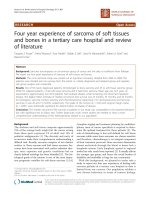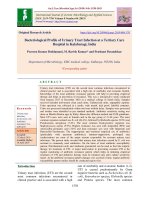Seroprevalence of syphilis in patient attending Tertiary Care Hospital, Valsad, India
Bạn đang xem bản rút gọn của tài liệu. Xem và tải ngay bản đầy đủ của tài liệu tại đây (224.37 KB, 5 trang )
Int.J.Curr.Microbiol.App.Sci (2017) 6(6): 2702-2706
International Journal of Current Microbiology and Applied Sciences
ISSN: 2319-7706 Volume 6 Number 6 (2017) pp. 2702-2706
Journal homepage:
Original Research Article
/>
Seroprevalence of Syphilis in Patient Attending
Tertiary Care Hospital, Valsad, India
Hiral K. Patel*, Parimal H. Patel and Alka B. Nerurkar
Faculty Quarter, GMERS Medical College Campus, Halar road, Nanakwada, Valsad, India
*Corresponding author
ABSTRACT
Keywords
Guava,
Softwood grafting,
Shade house,
Open condition.
Article Info
Accepted:
26 June 2017
Available Online:
10 July 2017
Syphilis is a sexually transmitted disease (STD) caused by Treponema pallidum.
Prevalence of syphilis is changing in India recently because of availability of good
laboratory diagnosis, treatment and increase health awareness. But it still remains as major
public health problem with significant regional variations. Determine the seroprevalence of
syphilis in various patients attending tertiary care hospital, Valsad. This retrospective study
was conducted in a tertiary care teaching hospital Valsad in South Gujarat from May 2016
to April 2017 over a period of one year. Blood samples received from various patient
groups including antenatal cases, patients attending sexually transmitted disease (STD)
clinic and high risk cases were screened by Non specific treponemal test [Rapid Plasma
Reagin (RPR) test] and specific treponemal test (Treponema pallidum
Immunochromatography assay). From total 2938 samples only 63 were positive by
qualitative RPR test. Of these 58 cases were confirmed by quantitative RPR test and
Treponema pallidum immunochromatography assay. The overall seroprevalence found in
this study was 1.97%. The seroprevalence of patients attending the sexually transmitted
infection clinic, antenatal group and among the HIV positive individuals were 4.11%,
0.28% and 6.25% respectively. The present study found lower seroprevalence of syphilis
in antenatal cases and in STD clinics. These findings could be interpreted as indicators of
improved programmes for prevention and management of STDs. Even though the
prevalence of syphilis is on the decline, screening of high risk populations should be
continued to avoid the complications of undiagnosed and untreated syphilis.
Introduction
Syphilis, a sexually transmitted disease (STD)
caused by Treponema pallidum, is associated
with significant complications if left untreated
and can facilitate the transmission and
acquisition of HIV infection (World Health
Organization, 2001). Maternal syphilis causes
stillbirths and spontaneous abortion in 80% of
cases and survivors are at risk of severe
effects and long-term squealae. Screening for
syphilis can prevent complications of
syphilis and reduce transmission, which in
turn will reduce the occurrence of congenital
syphilis and transmission of human
immunodeficiency virus (HIV) infection and
other sexually transmitted infections (Schmid
et al., 2007). It can be successfully controlled
by effective public health measures due to the
availability of a sound diagnostic test and
effective economical treatment options.
2702
Int.J.Curr.Microbiol.App.Sci (2017) 6(6): 2702-2706
The World Health Organization estimates 5.6
million new syphilis cases in women and men
aged 15–49 years globally. Based on data for
2005 to 2012, the estimated pooled
prevalence for syphilis the global estimate
was 0.5% and the regional values ranged from
0.2% to 1.8% (Newman et al., 2015). Various
studies from India have shown varied rates of
syphilis depending upon the population study.
Studies from STD clinics and Antenatal
groups have shown seroprevalence ranging
from 5.4% to 8.2% and 0.84% to 0.98%
respectively (Maity et al., 2011; Archana et
al., 2014). Antibody detection by non
treponemal/ cardiolipin and treponemal tests
are the mainstay for diagnosing syphilis and
for monitoring the success of subsequent
antibiotic treatment (Centers for Disease
Control and Prevention, 2010; Müller et al.,
2014). So the main aim of the present study
was to understand the occurrence of syphilis
among various patient groups attending a
tertiary care hospital.
Materials and Methods
This retrospective study was conducted in a
tertiary care teaching hospital Valsad in South
Gujarat from May 2016 to April 2017 over a
period of one year. The samples were
received from Patients at high risk for syphilis
with clinical suspension of syphilis/as a part
of routine screening for HIV seropositive
patients attending ART center, Pregnant
women attending antenatal clinics, STD clinic
attendees without HIV and patients from
OPDs or admitted to other wards of our
tertiary care hospital. Serum samples from all
patients were tested by qualitative Rapid
Plasma Reagin RPR (nonspecific treponemal
test) using standard procedures mentioned in
the kit manual. Samples positive for
qualitative RPR were subjected to a
quantitative RPR test using serum dilutions
from 1 in 2 up to 1 in 128. A specific
treponemal test, Treponema pallidum
immunochromatographic
assays
was
performed on samples positive in the
quantitative RPR tests. Samples positive in
both tests were designated as seropositive for
syphilis.
Results and Discussion
A total of 2938 samples were tested during
this study period. Among them 63 were
positive by qualitative RPR test. Of these 58
were positive by quantitative RPR and
Treponema
pallidum
immune
chromatographic
assays.
Overall
seroprevalence of syphilis found in this study
was 1.97%.
Among the various sub-populations study,
patients attending the sexually transmitted
infection clinic showed a seroprevalence of
4.11%. The antenatal group showed a
seroprevalence of 0.28 %. Among the HIV
positive individuals screened for syphilis,
6.25% were positive for treponemal
antibodies. Miscellaneous groups of patients
admitted to other broad specialties with
features suggestive of secondary or tertiary
syphilis
were
also
screened.
The
seropositivity in this group was 2.76%.
Seroprevalence of syphilis among various
sub-population groups is shown in table 1.
Among these syphilis positive patients,
40(68.96%) were male and 18 (31.04%) were
female. Majority of them were in the age
group of 15-50.i.e. (91.37%) The age and sex
distribution of cases is shown in the table 2.
A rise in the prevalence of syphilis has been
observed in various studies in India and other
countries (Centers for Disease Control and
Prevention Sexually Transmitted Diseases
Survillance, 2012; PHE, 2013; Ray et al.,
2006). Seroprevalence of syphilis found in
this study was 1.97%, which is higher than
the other hospital based study by Sethi et al.,
2703
Int.J.Curr.Microbiol.App.Sci (2017) 6(6): 2702-2706
(2015) in which highest seroprevalence was
1.79% in year 2011. A rise in seroprevalence
of syphilis was observed when all groups
were analyzed together. Such findings have
also been reported from USA, Germany, and
Sweden. In USA, the rise in the prevalence
has been ascribed to increased number of men
who have sex with men (MSM) and reduction
in safe sex practices among them. While in
Europe, the rise attributed to increase number
of MSM as well as increase testing in highrisk groups. A rising trend of secondary
syphilis has been reported in hospital- based
studies from India in past by Ray et al.,
(2006). This could be because of excessive
reliance of preventive programs on the
syndromic management of genital ulcer.
Only those patients positive by both
quantitative RPR and Treponema pallidum
immunochromatographic assay were analyzed
to study the seroprevalence of syphilis. This
was done to exclude the biological false
positivity by RPR. In our study 0.17%
biological false positivity by RPR was
observed. Bala et al., (2013) reported 0.2%
biological false positivity by VDRL test and
concluded that confirmatory tests should be
performed in all sera reactive with VDRL
regardless its titer.
The present study was determined the
seroprevalence of syphilis in various
subgroups of patients attending tertiary care
hospital. Various studies from India have
shown varied rates of syphilis depending
upon the population study. Studies from STD
clinics have shown seroprevalence ranging
from 5.4% to 8.2%. This study showed the
lower Seroprevalence (4.11%). These
findings could be interpreted as indicators of
improved programs for prevention and
management of STDs as well as availability
of treatment in STD clinics.
Table.1 Seroprevalence of syphilis among various sub-population groups
Various groups
Antenatal cases
Patients attending STD
clinics
HIV positive
Others
No.of tested
1739
437
No. of positive
5
18
Percentage
0.28%
4.11%
400
362
25
10
6.25%
2.76%
Table.2 Age and Sex distribution among Syphilis positive patients
(N=58)
Age groups
˂ 15 year
16-50 year
˃50 year
Total (N=58)
Male
1(1.73%)
36(62.05%)
3(5.18%)
40(68.96%)
Female
1(1.73%)
17(29.31%)
18(31.04%)
Indian studies on syphilis from antenatal
groups have shown a Seroprevalence of
0.84% to 0.98%. Low seroprevalence of
0.28% was also seen in the current study.
However, as syphilis can cause adverse
outcomes of pregnancy in 80% of the cases,
Total
2(3.46%)
53(91.36%)
3(5.18%)
58(100%)
including stillbirths, abortions, perinatal death
and neonatal infections in a significant
number of cases, the importance of screening
antenatal women for syphilis should always
be highlighted (WHO, 2007).
2704
Int.J.Curr.Microbiol.App.Sci (2017) 6(6): 2702-2706
Co-infection rates of syphilis and HIV have
been showing a worrisome trend in several
countries, with urban outbreaks in men who
have sex with men showing rates of 20%73% (Patton et al., 2014). In India, variable
syphilis-HIV coinfection rates have been
described (Shaw et al., 2011). Even though
our study shows that 6.25% of diagnosed HIV
patients were positive for syphilis, the results
have to be interpreted with caution. The HIV
positive individuals included in our study
were symptomatic individuals who had
presented to clinic for antiretroviral treatment.
Therefore, all HIV positive individuals were
not screened in the study unlike other studies
which have screened large HIV positive
cohorts. Syphilis and HIV co-infection
presents a complex interaction. The increased
incidence of HIV in homosexual and
heterosexual individuals afflicted with STD,
including syphilis is epidemiologically
documented in numerous studies (Ross et al.,
2014). HIV alters the course of syphilis as
well as the response to treatment. Incidence of
neurosyphilis in HIV infected individuals is
high even when treated with recommended
dosage (Tsai et al., 2012).
Patients from OPDs or admitted to other
wards with features suggestive of secondary
or tertiary syphilis were screened and
seroprevalence of this group was 2.76%
which is similar with the study by Khan et al.,
(2014).
In the present study more males (68.96%)
were positive as compared to female
(31.04%), which correlates with the other
study by Nishal et al., (2015). This might be
due to higher social stigma of reporting to STI
clinics in females. Majority of the patient
were in the age group of 15-50 year as has
been seen in other study as mainly because of
high sexual activity in this age group (Nishal
et al., 2015). The seroprevalence of syphilis
found in this study was 1.97%. We found
lower seroprevalence in antenatal groups as
well as in Patients attending STD clinics.
Higher seroprevalence in HIV positive
patients and patients from other wards and
OPDS calls for continued and sustained effort
for case detection, treatment and other
preventive measure to contain the disease.
Our study had several limitations. Its
retrospective nature limited evaluation of
several parameters like risk evaluation of
particular groups such as men who have sex
with men, rural and urban population etc.
Secondly, it was a hospital based study and
population-based community studies are
likely to show different results.
References
Archana, B.R., Prasad, S.R., Beena, P.M.,
Okade, R., Sheela, S.R., Beeregowda,
Y.C. 2014. Maternal and congenital
syphilis in Karnataka, India. Southeast
Asian J. Trop. Med. Public Health, 45(2):
430-43.
Bala, M., Singh, V., Muralidhar, S., Ramesh, V.
2013. Assessment of reactivity of three
treponemal tests in non-treponemal nonreactive cases from sexually transmitted
diseases clinic, antenatal clinic, integrated
counselling and testing centre, other
different
outdoor
patient
departments/indoor patients of a tertiary
care centre and peripheral health clinic
attendees. Indian J. Med. Microbiol.,
31(3): 275-27.
Centers for Disease Control and Prevention
Sexually
Transmitted
Diseases
Survillance.
2012.
Atlanta:
U.S.
Department of health and human services.
Centers for Disease Control and Prevention.
2010. Sexually Transmitted Diseases
Treatment Guidelines, 2010. MMWR
Morb. Mortal Wkly. Rep., 59: 27-8.
Khan, S., G.A. Menezes, R. Dhodapkar, B.N.
Harish. 2014. Seroprevalence of syphilis
in patients attending a tertiary care
hospital in Southern India. Asian Pac. J.
Trop. Biomed., 4(12): 995-997.
2705
Int.J.Curr.Microbiol.App.Sci (2017) 6(6): 2702-2706
Maity, S., Bhunia, S.C., Biswas, S., Saha, M.K.
2011. Syphilis Seroprevalence among
patients attending a sexually transmitted
disease clinic in West Bengal, India. Jpn.
J. Infect. Dis., 64(6): 506-508.
Müller, I., Brade, V., Hagedorn, H.J., Straube,
E., Schörner, C., Frosch, M. 2014. Is
serological testing a reliable tool in
laboratory
diagnosis
of
syphilis?
Meta‑ analysis of eight external quality
control surveys performed by the German
infection serology proficiency testing
program. J. Clin. Microbiol., 44: 1335-41.
Newman, L., Rowley, J., Vander Hoorn, S.,
Wijesooriya, N.S., Unemo, M., Low, N.
2015. Global Estimates of the Prevalence
and Incidence of Four Curable Sexually
Transmitted Infections in 2012 Based on
Systematic Review and Global Reporting.
PLoS
ONE,
10(12):
e0143304.
doi:10.1371/journal.pone.0143304.
Nishal, P.K., Kapoor, A., Jain, V.K., Dayal, S.,
Aggrawal, K. 2015. Changing trends in
acquired syphilis at tertiary care center of
North India. Indian J. Sex Transm. Dis.,
36(2): 149-153.
Patton, M.E., Su, J.R., Nelson, R., Weinstock,
H. 2014. Centers for Disease Control and
Prevention
(CDC).
Primary
and
secondary syphilis-United States, 20052013. MMWR Morb. Mortal Wkly. Rep.,
63(18): 402-406.
PHE. 2013. Recent Epidemiology of Infectious
syphilis and congenital syphilis Health
protection report, 7.
Ray, K., Bala, M., Gupta, S.M., Khunger, N.,
Puri, P., Muralidhar, S. 2006 Changing
trends in sexually transmitted infectionsat
a Regional STD Centre in north India.
Indian J. Med. Res., 124: 559-68.
Ross, M.W., Nyoni, J., Ahaneku, H.O.,
Mbwambo, J.,
McClelland, R.S.,
McCurdy, S.A. 2014. High HIV
seroprevalence, rectal STIs and risky
sexual behaviour in men who have sex
with men in Dar es Salaam and Tanga,
Tanzania. BMJ Open, 4(8): e006175.
Schmid, G.P., Stoner, B.P., Hawkes, S.,
Broutet, N. 2007. The need and plan for
global elimination of congenital syphilis.
Sex Transm. Dis., 34: S5-10.
Sethi, S., Mewara, A., Hallur, V., Prasad, A.,
Sharma, K., and Raj, A. 2015. Rising
trends in syphilis in a tertiary care center
in North India. Indian J. Sex Transm.
Dis., 36(2): 140-143.
Shaw, S.Y., Deering, K.N., Reza-Paul, S., Isac,
S., Ramesh, B.M., Washington, R. 2011.
Prevalence of HIV and sexually
transmitted infections among clients of
female sex workers in Karnataka,India: a
cross-sectional study. BMC Public
Health, 11(Suppl 6): S4.
Tsai, H.C., Sy, C.L., Lee, S.S., Wann, S.R.,
Chen, Y.S. 2012. Optimal treatment for
asymptomatic neurosyphilis. Int. J. STD
AIDS, 23(10): 756-757.
WHO. 2007. The Global Elimnation of
congenital Syphilis: Rationale and
strategy for action, Geneva; World Health
Organisation.
World Health Organization, Department of
HIV/AIDS. 2001. Global prevalence and
incidence of selected curable sexually
transmitted diseases: overview and
estimates. Geneva: World Health
Organization.
How to cite this article:
Hiral K. Patel. 2017. Seroprevalence of Syphilis in patient attending Tertiary Care Hospital,
Valsad. Int.J.Curr.Microbiol.App.Sci. 6(6): 2702-2706.
doi: />
2706









